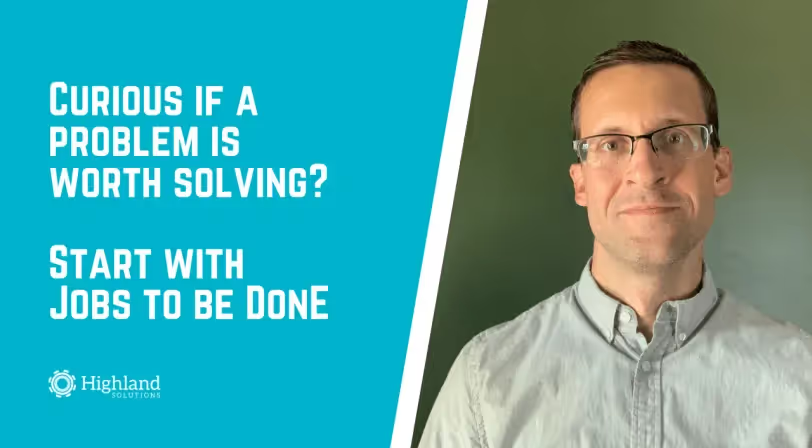Most business leaders I know have some sort of transformational, digital idea that they’re thinking about executing someday; some way to launch a digital product or a digital experience that really transforms what they do today.
A lot of those leaders know that most digital products fail. They’re not very successful. At Highland, we help people launch digital things for a living. So when people ask me, “Okay, I have this idea, this transformational digital idea…”
“Where do I start? What do I do first so that I have a better chance of being successful?”
Our instinct is to think that what makes digital products successful or not is how strong a solution is. We say things fail because they weren’t sufficiently better than other things out there.
But in my experience, most digital products fail because they don’t sufficiently understand the problem they’re trying to solve. And if you want to understand the problem, then the right place to start is with an idea and a research method called Jobs to be Done (JTBD).
A 2-Minute Primer on Jobs to be Done
Jobs to be Done the idea says that as human beings, we’re trying to make progress in our lives. We want to get things done. We want to wake up better this morning. And to do that, I hire a product or service — I could be giving it money or not.
Take waking up: I could use a shower to wake up in the morning. Or I could use a cup of coffee. This morning I hired an AeroPress to make that cup of coffee for me. But I could’ve hired Starbucks or Dunkin’ Donuts or an instant coffee or even one of those fancy subscription services that send single-source beans to my door every month.
Jobs has this idea that people hire things. It’s called a switch moment. When I use my coffee pot or I go to Starbucks or I subscribe to a coffee service. Those are all switch moments: a Job that I’m trying to get done and a thing that I’m hiring to accomplish it.
In my experience, those are really simple, straightforward Jobs. Most of the things that we interact with that people are trying to solve are more complicated human problems or aspirations.
For example, say my idea is to build a chore app for parents and kids to organize chores, schedules, and maybe some allowance that kids can earn by performing their chores.
If I’m solution-oriented, what I’m probably going to do is Google the Play Store and the Apple Store and look around for like who else has a chore app? What are they doing? And start thinking about how can I do that better? Or what’s different about the chore app that I’m preparing to release?
But if we approach the problem first and we use Jobs thinking, we would go talk to some of those parents. I think we would find that the parents, their Job is not actually to find a better chore app.
Their Job is to raise a kid who is responsible with money, has a good perspective and world view and wisdom about money. That isn’t entitled.
That’s the Job the parent is trying to accomplish.
Well, the magic of Jobs thinking is that if we understand that that’s actually the problem, two things happen:
- We get to understand how important the Job is to those people
- We think about other things a person might consider to solve the Job
So, how important is the Job of raising a kid who is responsible with money? In this case, that job’s probably pretty important. They’re probably going to seek some sort of solution to solve it.
That gets us past hurdle number one, which is often that the Job we’re targeting is just not important enough to the people that we’re trying to serve for them to hire anything.
But it also gets us to the second question, which is: What other things might a person be considering to solve that Job?
Jobs thinking is so helpful because it opens us up to the truth that there’s a huge array of things being considered to solve that Job. In this case, it might be Grandma’s advice. There’s probably a book or some online articles, it might be a course, all sorts of things that a parent might hire over time to try to get at the Job of raising a kid who is wise about money.
And so, Jobs thinking really helps me with the idea of a chore app. I might find that there are some new learnings I need to incorporate or that there’s maybe a better way to go about solving that underlying problem than what I thought.
And I might actually discover that the wrong thing to do is try to build a better chore app. I might find in Jobs that my digital idea is not a very successful way for parents to get at the underlying thing they’re trying to accomplish, which is to raise a kid that is responsible with money.
So, if you have a new digital idea, whether it targets a simple Journey or a complex Journey, don’t start with the solution. Start with the problem. Start with Jobs thinking.
What’s the underlying problem I’m trying to solve?
Is it important enough to actually be worth solving?
And what other things are being considered when someone’s hiring a product service to solve that Job.
That’s the right place to start.



